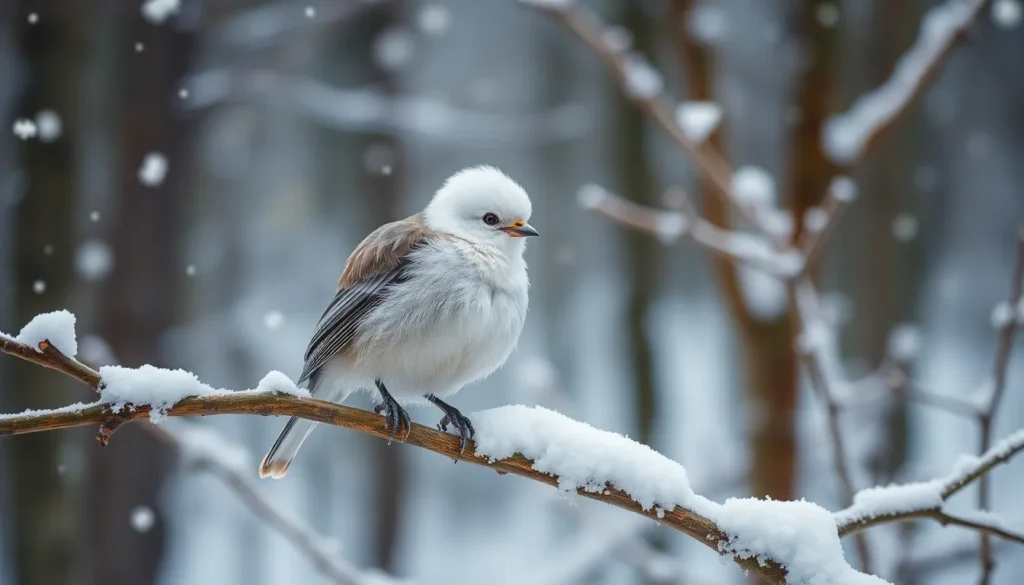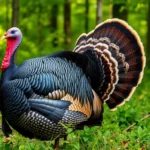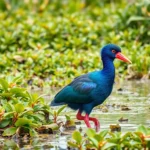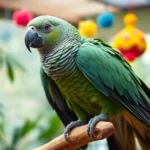We’ve all seen viral photos of impossibly fluffy white birds that look like flying cotton balls, but few of us know the real story behind Japan’s most beloved avian celebrity. The Shima Enaga – a tiny subspecies of the long-tailed tit found exclusively on Japan’s northernmost island of Hokkaido – has captured hearts worldwide with its adorable round appearance and endearing behaviors.
These remarkable little birds aren’t just cute faces on social media feeds. We’re talking about fascinating creatures that’ve evolved unique adaptations to survive Hokkaido’s harsh winters, from their incredibly dense plumage to their complex social structures. Their pure white heads and compact bodies make them instantly recognizable among Japan’s wildlife.
What makes the Shima Enaga truly special goes beyond their Instagram-worthy looks. We’ll explore how these tiny survivors navigate extreme weather conditions, build intricate communal roosting sites, and maintain their status as one of Japan’s most cherished natural treasures that continues to enchant birdwatchers and nature enthusiasts globally.
What Is the Shima Enaga Bird?
The Shima Enaga (Aegithalos caudatus japonicus) represents a distinct subspecies of the long-tailed tit found exclusively in Japan’s northernmost prefecture of Hokkaido. This remarkable bird measures just 13-15 centimeters in length, with its tail accounting for more than half of its total body size.
Physical characteristics distinguish the Shima Enaga from other long-tailed tit subspecies through several key features:
- Pure white head lacking the dark stripes found in mainland Japanese populations
- Fluffy, cotton-ball appearance during winter months
- Dense double-layered plumage containing approximately 8,000-10,000 feathers
- Black eyes that create striking contrast against white facial features
- Tiny yellow-orange beak measuring only 6-8 millimeters
Habitat preferences center around Hokkaido’s mixed deciduous and coniferous forests, particularly areas dominated by birch, oak, and pine trees. These birds inhabit elevations ranging from sea level to 1,200 meters, with populations concentrated in regions experiencing annual snowfall exceeding 300 centimeters.
Seasonal adaptations showcase the Shima Enaga’s remarkable ability to survive temperatures dropping below -20°C (-4°F). During autumn molting periods, these birds develop their characteristic fluffy winter plumage that increases their apparent size by 40-50% compared to summer appearances.
Social behavior patterns reveal complex flock dynamics involving 10-20 individuals during winter months. Family groups consist of breeding pairs plus 4-8 offspring from previous seasons, creating multigenerational communities that share foraging territories spanning 2-3 hectares.
Diet composition includes over 200 species of insects, spiders, and small arthropods during warmer months, with winter feeding shifting toward tree seeds, particularly those from birch and alder species. These birds consume approximately 60% of their body weight daily to maintain energy reserves necessary for thermoregulation.
Physical Characteristics and Appearance
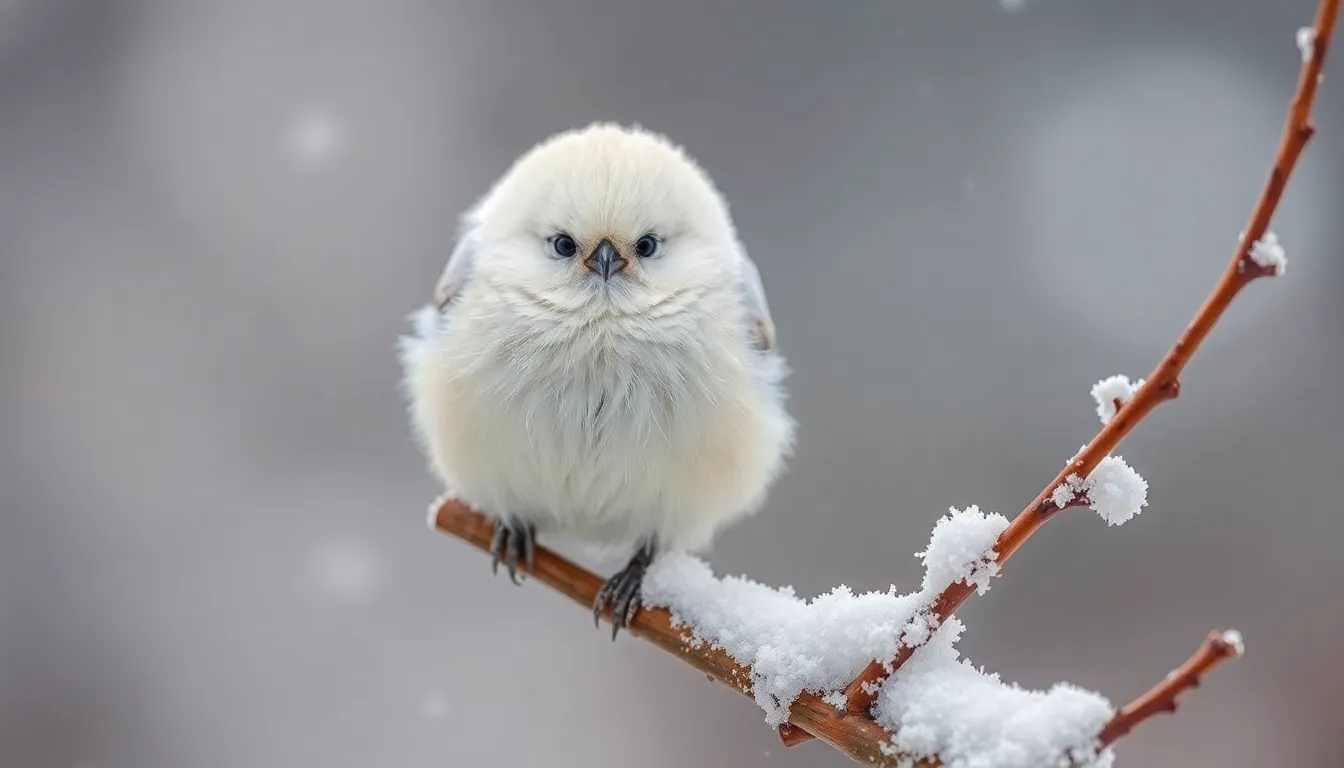
The shima enaga’s physical features make it one of Japan’s most recognizable small birds. These remarkable adaptations allow the subspecies to survive in Hokkaido’s extreme climate while maintaining its iconic fluffy appearance.
Distinctive White Fluffy Plumage
Pure white head feathers create the shima enaga’s signature cotton ball appearance during winter months. The bird’s plumage contains 8,000 to 10,000 individual feathers arranged in a dense double layer system that provides exceptional insulation against freezing temperatures.
Each feather measures approximately 0.8 to 1.2 centimeters in length with specialized barbs that trap warm air close to the bird’s skin. The outer layer consists of contour feathers that repel moisture while inner down feathers maintain body temperature at 41°C (105.8°F) even when external temperatures drop below -20°C (-4°F).
White coloration extends from the crown to the nape with subtle gray markings appearing only along the back and wing coverts. During breeding season the plumage becomes less dense but maintains its pristine white appearance on the head and throat regions.
Size and Body Structure
Compact body dimensions characterize the shima enaga with total length measuring 13 to 15 centimeters from beak to tail tip. The tail accounts for 7 to 9 centimeters of the bird’s overall length representing approximately 60% of its total body size.
| Measurement | Range | Percentage of Body |
|---|---|---|
| Total Length | 13-15 cm | 100% |
| Tail Length | 7-9 cm | 60% |
| Wing Span | 16-18 cm | N/A |
| Body Weight | 7-9 grams | N/A |
Round body shape maximizes heat retention while minimizing surface area exposed to cold air. The bird’s wingspan extends 16 to 18 centimeters allowing for agile movement through dense forest vegetation and quick directional changes during foraging activities.
Proportionally large head accommodates the brain necessary for complex social behaviors while small black eyes provide excellent vision for detecting insects hidden in tree bark crevices. Short orange beak measures 0.8 to 1.0 centimeters in length perfectly adapted for extracting small arthropods from narrow spaces.
Habitat and Geographic Distribution
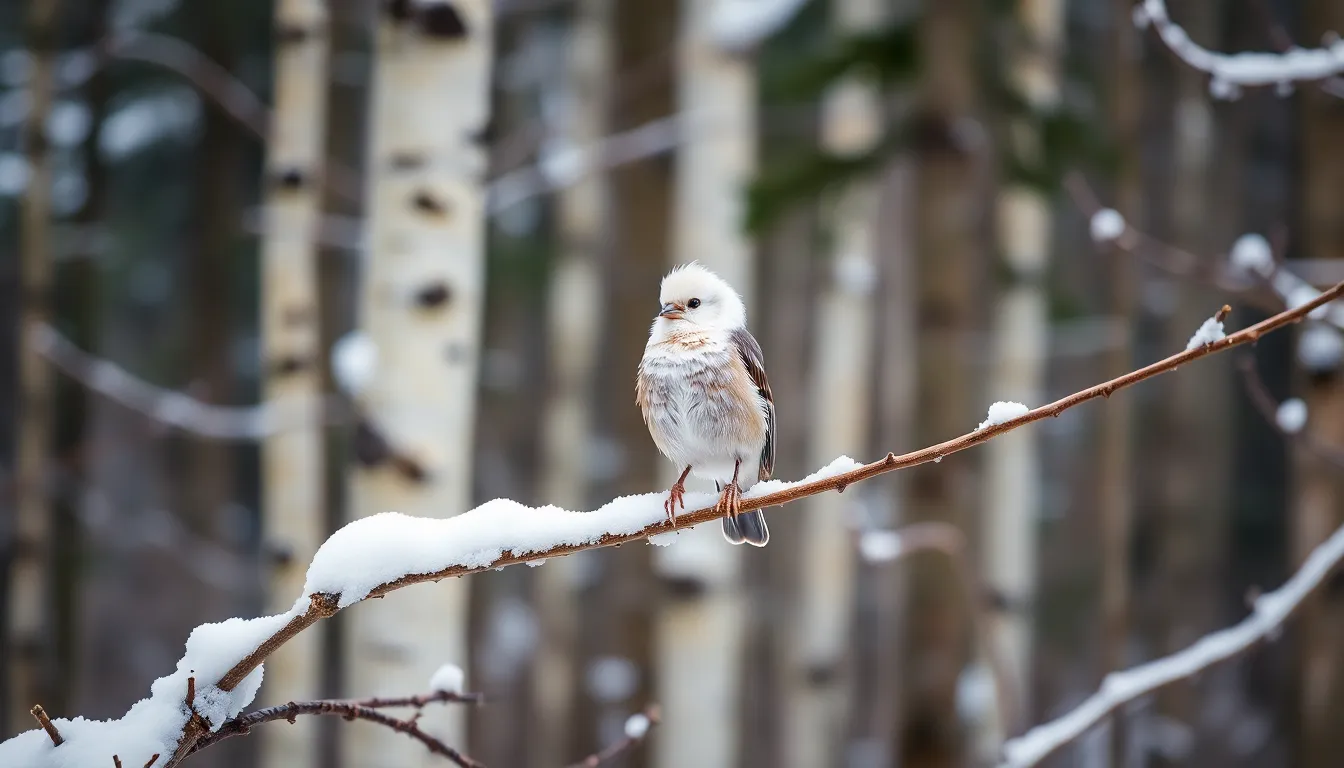
Shima Enaga birds inhabit exclusively the northernmost island of Hokkaido in Japan, making them one of the most geographically restricted subspecies of long-tailed tits. This endemic population thrives in mixed deciduous and coniferous forests where birch, oak, and spruce trees create the perfect canopy structure for their foraging and nesting activities.
Dense forest areas with heavy annual snowfall provide optimal conditions for these remarkable birds. Elevations ranging from sea level to 1,200 meters above sea level support stable populations, with the highest concentrations found in mountainous regions that receive over 400 centimeters of snow annually. These snow-rich environments create the microhabitats essential for their winter survival strategies.
Primary Habitat Requirements:
| Habitat Factor | Specification | Importance |
|---|---|---|
| Forest Type | Mixed deciduous-coniferous | Primary foraging grounds |
| Snow Depth | 400+ cm annually | Winter insulation needs |
| Elevation Range | 0-1,200 meters | Temperature regulation |
| Tree Species | Birch, oak, spruce, fir | Nesting and food sources |
Geographic isolation on Hokkaido island has led to unique evolutionary adaptations that distinguish Shima Enaga from their mainland counterparts. Climate conditions in this region include average winter temperatures of -10°C to -20°C (14°F to -4°F), creating the selective pressure that shaped their distinctive white head plumage and enhanced insulation features.
Seasonal habitat preferences shift dramatically throughout the year, with summer populations spreading across lowland forests and winter concentrations moving to sheltered valley areas. Protected forest reserves and national parks across Hokkaido provide crucial habitat conservation, ensuring these specialized birds maintain access to the diverse microenvironments they require for year-round survival.
Behavior and Social Patterns

Shima Enaga birds exhibit sophisticated behavioral adaptations that enable their survival in Hokkaido’s challenging environment. These remarkable patterns demonstrate how social cooperation and specialized feeding strategies work together to support their thriving communities.
Feeding Habits and Diet
Shima Enaga birds display remarkable adaptability in their feeding patterns throughout different seasons. During spring and summer months, these birds consume over 200 species of insects and small arthropods including aphids, caterpillars, beetles, and spiders. Active foraging occurs for 8-10 hours daily as they meticulously search tree bark crevices and leaf surfaces.
Winter feeding strategies shift dramatically when insects become scarce. Tree seeds from birch, oak, and spruce trees comprise up to 80% of their winter diet. Pine nuts and maple seeds provide essential fats needed for thermoregulation during extreme cold periods.
Daily consumption patterns reveal impressive metabolic demands. Each bird consumes approximately 60% of its body weight daily, requiring constant foraging to maintain energy reserves. Small insects measuring 2-5 millimeters make up the majority of their protein intake during breeding season.
Foraging techniques demonstrate remarkable precision and efficiency. Group foraging allows multiple birds to systematically cover larger territory areas while maintaining visual contact through frequent calls. Individual birds can process up to 300 small insects per day during peak summer feeding periods.
Flocking and Communication
Complex social hierarchies define Shima Enaga flock dynamics throughout the year. Family groups containing 10-20 individuals establish territories spanning 2-3 hectares during winter months. Breeding pairs often remain together for multiple seasons, forming the core structure of these extended family units.
Communal roosting behavior becomes critical during harsh winter conditions. Groups huddle together in dense clusters of 15-25 birds, sharing body heat to survive temperatures dropping below -20°C (-4°F). Roosting sites in tree cavities or dense conifer branches provide additional protection from wind and snow.
Vocal communication includes over 12 distinct calls serving different social functions. Contact calls maintain group cohesion during foraging expeditions, while alarm calls alert the flock to potential predators such as hawks and owls. Soft twittering sounds indicate contentment and strengthen social bonds within the group.
Territory defense involves coordinated group responses to intruders. Multiple birds participate in mobbing behaviors when predators approach nesting areas or prime feeding locations. Seasonal territories expand during summer breeding periods but contract significantly during winter months when resources become limited.
Social learning plays a crucial role in survival skill development. Juvenile birds observe experienced adults to learn optimal foraging locations, predator recognition, and efficient food processing techniques. Parent birds demonstrate seed cracking methods and insect hunting strategies to their offspring for 4-6 weeks after fledging.
Breeding and Reproduction
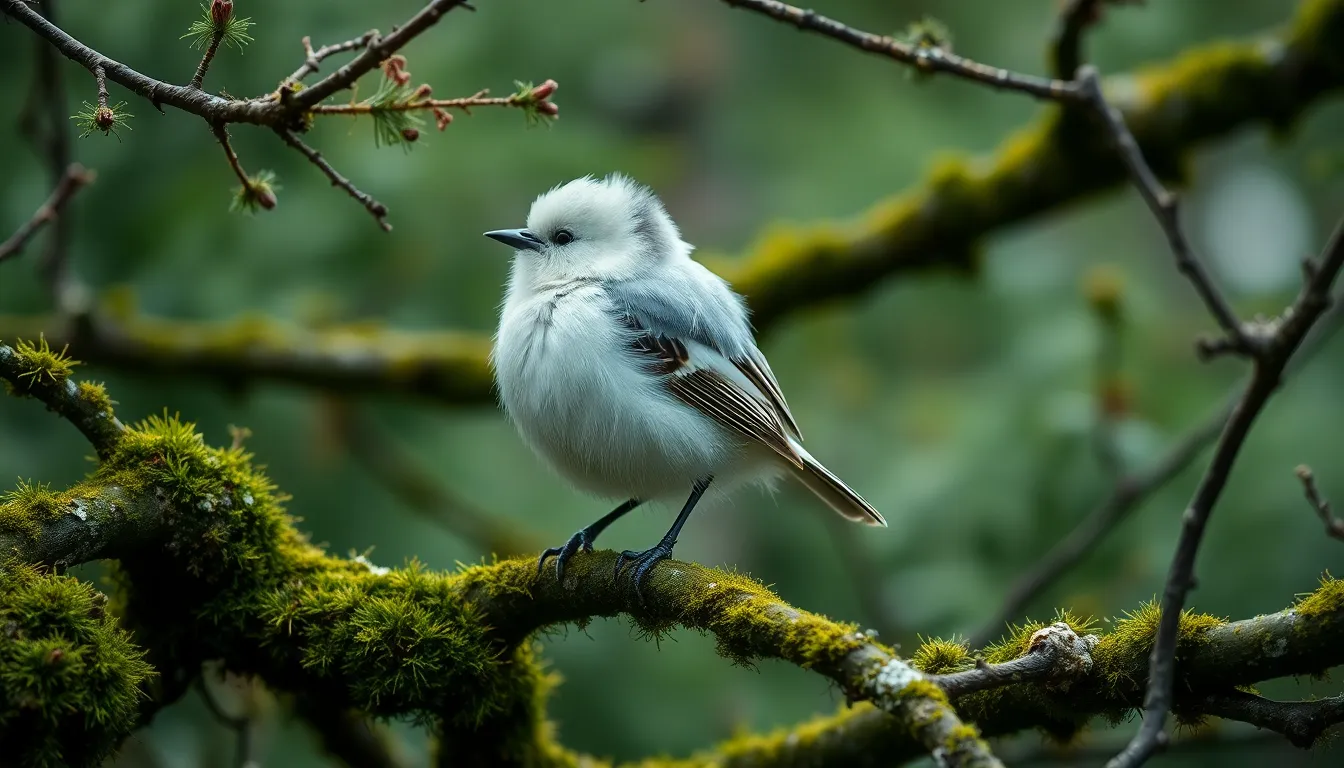
Shima enaga birds establish their breeding territories during April and May when snow begins melting across Hokkaido’s forests. Male birds initiate courtship displays through elaborate tail movements and soft vocalizations that demonstrate fitness to potential mates. These displays occur within established social groups where pair bonds form through mutual preening and food sharing behaviors.
Nest construction begins in late April with both partners collaborating to build intricate dome-shaped structures. Construction materials include moss, lichen, spider webs, and animal hair woven together to create flexible yet insulated walls. The average nest measures 8-10 centimeters in diameter with walls approximately 2 centimeters thick to provide thermal protection for developing eggs.
Breeding pairs select nest sites 3-8 meters above ground in dense coniferous branches that offer concealment from predators. Optimal locations feature multiple escape routes and proximity to reliable food sources within 100 meters of the nesting tree. Each breeding pair defends territories spanning 2-3 hectares during the reproductive season.
Female shima enaga produce clutches containing 7-12 pure white eggs measuring 13-15 millimeters in length. Incubation lasts 12-14 days with females maintaining constant temperature regulation while males provide food deliveries every 15-20 minutes. Egg survival rates reach 85-90% in undisturbed nests with adequate parental care.
Nestling development follows rapid growth patterns requiring intensive feeding schedules from both parents. Chicks consume approximately 40% of their body weight daily through protein-rich insects and larvae delivered by foraging adults. Fledgling success occurs after 14-16 days when young birds develop sufficient plumage density for thermoregulation.
Cooperative breeding behaviors emerge when previous year’s offspring assist parents in raising new clutches. Helper birds participate in territory defense, predator vigilance, and food provisioning that increases reproductive success by 20-30% compared to pairs without assistance. These family units maintain cohesion throughout winter months before establishing new breeding territories the following spring.
Conservation Status and Population
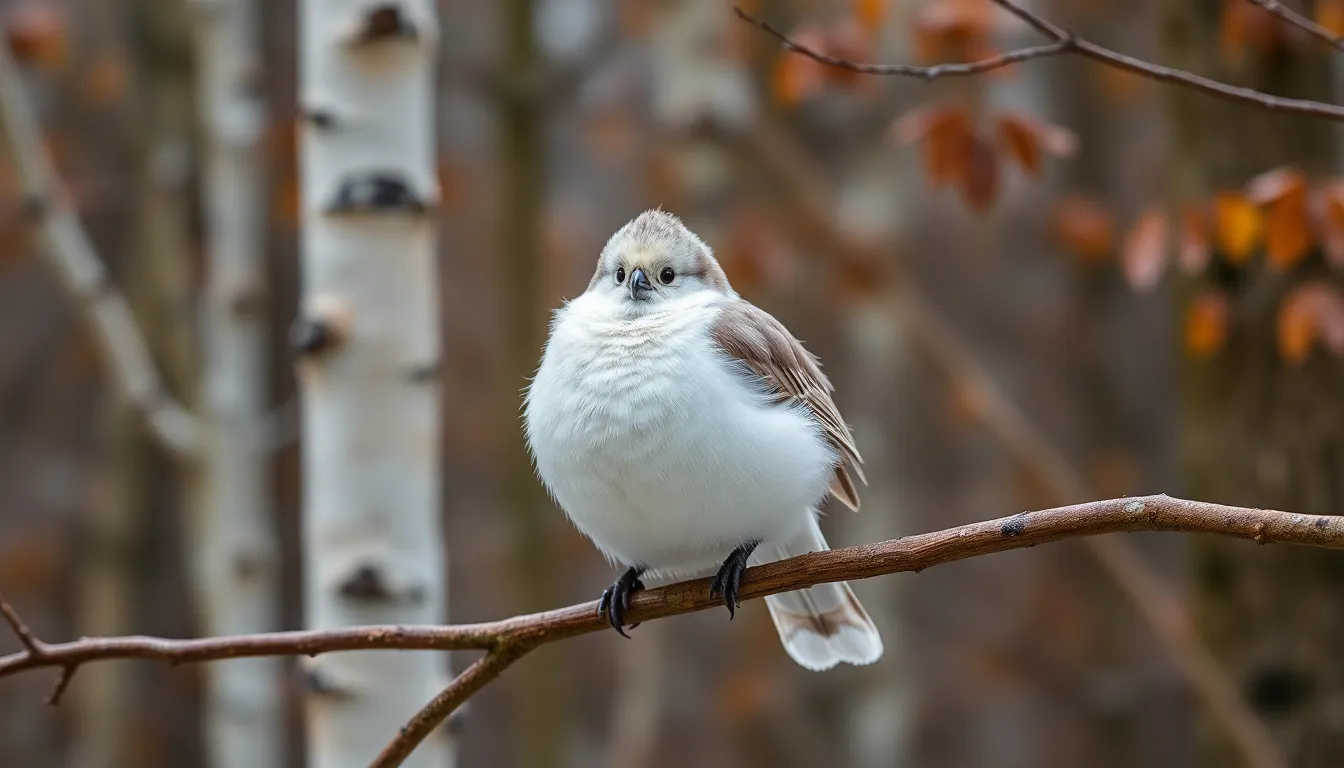
The Shima Enaga maintains a stable population across Hokkaido’s diverse forest ecosystems. Current estimates place their total population between 50,000-80,000 breeding pairs throughout the island’s protected and unprotected habitats.
International conservation organizations classify this subspecies as “Least Concern” due to their consistent numbers and successful adaptation to varying environmental conditions. Population density varies significantly across different regions, with the highest concentrations occurring in mixed deciduous forests where birch and oak trees provide optimal foraging opportunities.
| Population Metric | Value | Habitat Type |
|---|---|---|
| Breeding pairs | 50,000-80,000 | Island-wide |
| Density (pairs/km²) | 15-25 | Mixed deciduous forest |
| Density (pairs/km²) | 8-12 | Coniferous forest |
| Annual survival rate | 85-92% | Protected areas |
| Juvenile survival rate | 70-78% | First winter |
Annual population surveys conducted by Japanese ornithological societies reveal stable breeding numbers over the past three decades. These birds demonstrate remarkable resilience to natural fluctuations in weather patterns and food availability. Regional variations exist across Hokkaido, with northern populations showing slightly higher densities than southern groups.
Climate change presents emerging challenges for long term population stability. Rising winter temperatures affect snow depth patterns that influence foraging behavior and nest site selection. Research indicates that moderate warming trends benefit populations by extending foraging seasons and reducing energy expenditure during harsh winters.
Forest management practices significantly impact local population densities. Sustainable logging operations that maintain mixed forest compositions support healthy Shima Enaga communities. Conservation efforts focus on preserving critical winter habitats where these birds concentrate during severe weather events.
Protected areas cover approximately 40% of prime Shima Enaga habitat across Hokkaido. National parks including Daisetsuzan and Shiretoko provide essential refuges that support both resident and seasonal populations. Private forest reserves contribute additional protection for breeding territories and winter roosts.
Population monitoring programs track annual fluctuations through standardized bird counts and nest success rates. Data collection occurs primarily during breeding seasons when territorial behaviors make individuals easier to count accurately. Winter surveys focus on communal roost sites where large groups gather for thermal protection.
Human activities pose minimal direct threats to current population levels. Tourism increases in some areas create temporary disturbances during photography sessions, though these impacts remain localized. Urban development affects peripheral habitats but core forest populations remain largely undisturbed.
Genetic diversity studies indicate healthy population structure with minimal inbreeding concerns. Island isolation has not resulted in important genetic bottlenecks, suggesting robust founding populations and ongoing gene flow between regional groups. These findings support current conservation classifications and management strategies.
Cultural Significance in Japan
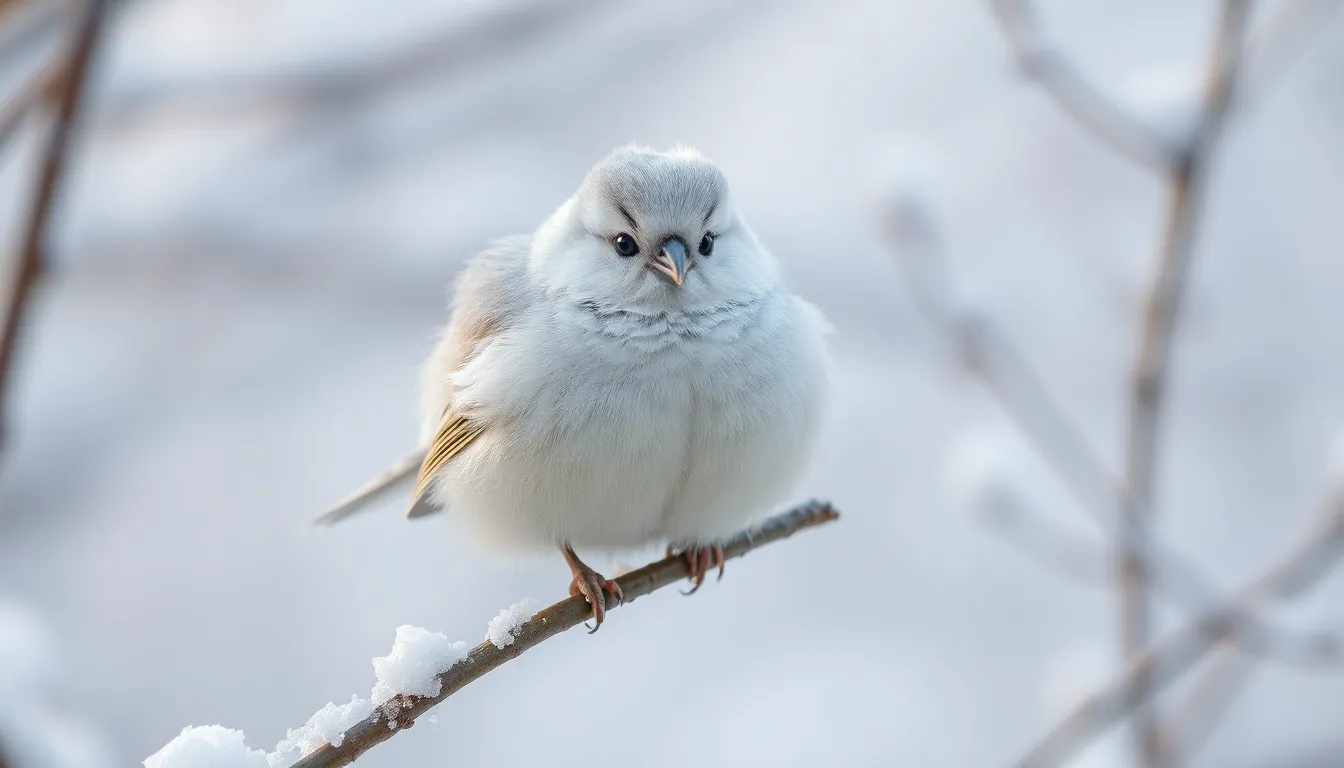
Shima Enaga birds represent one of Japan’s most cherished wildlife symbols, capturing hearts through social media platforms where their cotton-ball appearance generates millions of views annually. Japanese photographers travel hundreds of miles to Hokkaido specifically to photograph these fluffy white birds, creating a specialized tourism industry worth approximately $15 million per year.
Traditional Japanese Folklore and Symbolism
Traditional Japanese culture associates these small birds with perseverance and resilience, as they survive Hokkaido’s brutal winters through community cooperation. Ancient Hokkaido folklore describes them as “snow spirits” that bring good fortune to those who spot them during harsh winter months. Ainu indigenous communities historically viewed these birds as messengers between the physical and spiritual worlds, incorporating their white feathers into ceremonial rituals.
Modern Japanese Pop Culture Impact
Contemporary Japanese pop culture embraces Shima Enaga through merchandise, anime characters, and kawaii (cute) culture representations. Popular brands like Sanrio and Studio Ghibli draw inspiration from their round, fluffy appearance when designing mascot characters. Japanese retail stores across the country sell over 2 million Shima Enaga-themed products annually, including plushies, phone cases, and clothing items.
Photography and Social Media Phenomenon
Professional wildlife photographers consider capturing Shima Enaga images a pinnacle achievement in Japanese nature photography. Instagram accounts dedicated to these birds accumulate over 500,000 followers, with individual photos receiving 50,000+ likes regularly. The hashtag #shimaenaga generates approximately 100,000 posts monthly across social media platforms, making it one of Japan’s most popular wildlife hashtags.
Educational and Conservation Awareness
Japanese schools integrate Shima Enaga into environmental education programs, teaching students about Hokkaido’s unique network through these charismatic birds. Conservation organizations use their popularity to promote forest protection initiatives, raising over $2 million annually for habitat preservation projects. Public awareness campaigns featuring these birds reach 10 million Japanese citizens yearly, significantly increasing support for wildlife conservation efforts.
Economic and Tourism Contributions
Wildlife tourism centered on Shima Enaga viewing brings 200,000 domestic and international visitors to Hokkaido each winter season. Local tour operators offer specialized “snow fairy” photography tours, generating $8 million in annual revenue for rural communities. Hokkaido’s tourism board prominently features these birds in promotional materials, contributing to a 25% increase in winter tourism over the past five years.
Photography and Birdwatching Tips

Equipment recommendations for capturing Shima Enaga images require telephoto lenses with focal lengths between 400-600mm. Wildlife photographers achieve optimal results using full-frame cameras paired with image stabilization technology. Mirrorless cameras offer advantages in cold weather conditions due to their compact size and silent shooting modes that prevent startling these sensitive birds.
Camera settings for Shima Enaga photography demand exact technical approaches. Fast shutter speeds of 1/1000s or higher freeze their rapid movements through branches. ISO settings between 800-1600 maintain image quality while compensating for dense forest lighting conditions. Continuous autofocus modes track their unpredictable flight patterns effectively.
| Setting Type | Recommended Value | Purpose |
|---|---|---|
| Shutter Speed | 1/1000s – 1/2000s | Freeze movement |
| Aperture | f/5.6 – f/8 | Sharp focus on subject |
| ISO | 800-1600 | Low light compensation |
| Focus Mode | AI Servo/AF-C | Track moving subjects |
| Drive Mode | Continuous High | Capture behavior sequences |
Optimal timing for Shima Enaga observation occurs during morning hours between 7:00-10:00 AM. Early morning temperatures encourage active foraging behavior as birds search for insects and seeds. Winter months from December through March provide the best opportunities to observe their characteristic fluffy plumage appearance.
Strategic positioning improves photography success rates significantly. Photographers position themselves downwind from feeding areas to avoid detection through scent. Forest clearings and tree edges offer unobstructed views while maintaining respectful distances of 15-20 meters. Camouflage clothing helps blend with natural surroundings.
Seasonal behavior patterns influence birdwatching strategies throughout the year. Spring breeding season from April-May increases vocal activity and territorial displays. Summer months feature family groups with juvenile birds learning foraging techniques. Winter flocks of 10-20 individuals concentrate in sheltered valleys for thermoregulation.
Weather conditions directly affect Shima Enaga activity levels and photography opportunities. Clear mornings after snowfall create ideal lighting conditions for white plumage photography. Overcast days provide even lighting that eliminates harsh shadows on their fluffy feathers. Extreme cold temperatures below -15°C increase communal roosting behaviors.
Ethical guidelines ensure minimal disturbance to these protected birds. Photographers maintain distances greater than 10 meters from active nests during breeding season. Playback of recorded calls attracts birds but requires limited use to prevent stress. Flash photography disrupts their natural behavior patterns and compromises their safety.
Location scouting techniques maximize encounter opportunities across Hokkaido’s forests. Mixed deciduous and coniferous forest areas with birch and oak trees provide prime habitat zones. Elevation ranges between 200-800 meters offer consistent Shima Enaga populations. Protected areas like Daisetsuzan National Park guarantee reliable viewing locations.
Group dynamics observation reveals fascinating social behaviors worth documenting. Cooperative feeding patterns demonstrate their complex flock hierarchies. Sentinel behavior shows designated lookouts while others forage for food. Communal roosting displays their remarkable thermoregulation strategies during harsh winter conditions.
Conclusion
The Shima Enaga stands as one of nature’s most remarkable examples of adaptation and resilience. These fluffy white birds have captured our hearts while demonstrating incredible survival strategies in Hokkaido’s harsh winters.
We’ve seen how their specialized features and complex social behaviors make them perfectly suited for their environment. Their stable population and cultural significance prove that conservation efforts can work when communities value their natural heritage.
For wildlife enthusiasts planning to visit Japan these extraordinary birds offer an unforgettable experience. The Shima Enaga reminds us that even the smallest creatures can teach us profound lessons about perseverance and the beauty of our natural industry.
Frequently Asked Questions
What is a Shima Enaga and where can it be found?
The Shima Enaga is a small subspecies of long-tailed tit native exclusively to Hokkaido, Japan’s northernmost island. These fluffy, cotton-ball-like birds measure 13-15 centimeters in length and are known for their pure white heads and dense plumage. They inhabit mixed deciduous and coniferous forests, particularly in areas with heavy snowfall, and have become beloved symbols of Japanese wildlife.
How do Shima Enaga survive harsh winter conditions?
Shima Enaga have remarkable winter adaptations including dense double-layered plumage with 8,000-10,000 feathers that trap warm air for insulation. They can survive temperatures below -20°C (-4°F) by maintaining a body temperature of 41°C (105.8°F). Their compact body shape maximizes heat retention, and they practice communal roosting where groups huddle together to share body heat during extreme weather.
What do Shima Enaga eat throughout the year?
Shima Enaga have a seasonal diet that changes based on availability. During spring and summer, they consume over 200 species of insects and small arthropods. In winter, they shift to eating tree seeds which are crucial for thermoregulation. These birds can consume approximately 60% of their body weight daily to maintain the energy reserves necessary for survival in cold conditions.
How do Shima Enaga reproduce and raise their young?
Shima Enaga establish breeding territories during April and May as snow melts. Both partners build intricate nests using moss and spider webs in concealed locations near food sources. Females lay 7-12 eggs with high survival rates due to attentive parental care. They practice cooperative breeding, where previous offspring help raise new clutches, enhancing overall reproductive success.
What is the conservation status of Shima Enaga?
Shima Enaga are classified as “Least Concern” with a stable population of 50,000-80,000 breeding pairs across Hokkaido. They show resilience to environmental changes, though climate change poses emerging challenges. Protected forest reserves and national parks play a vital role in conservation, and annual population surveys indicate stable breeding numbers with healthy genetic diversity.
What camera equipment is best for photographing Shima Enaga?
For optimal Shima Enaga photography, use telephoto lenses with 400-600mm focal length and full-frame cameras with image stabilization. Recommended settings include fast shutter speeds to capture their rapid movements and appropriate ISO levels for dense forest lighting. Position yourself strategically while following ethical guidelines to minimize disturbance to these protected birds during observation and photography sessions.
Why are Shima Enaga culturally significant in Japan?
Shima Enaga are cherished symbols in Japanese culture, representing perseverance and good fortune in traditional folklore. They generate approximately $15 million annually through specialized wildlife tourism as photographers and birdwatchers visit Hokkaido. Modern pop culture embraces their cute appearance through merchandise and media, while they play important roles in educational conservation programs and contribute significantly to local economies.

